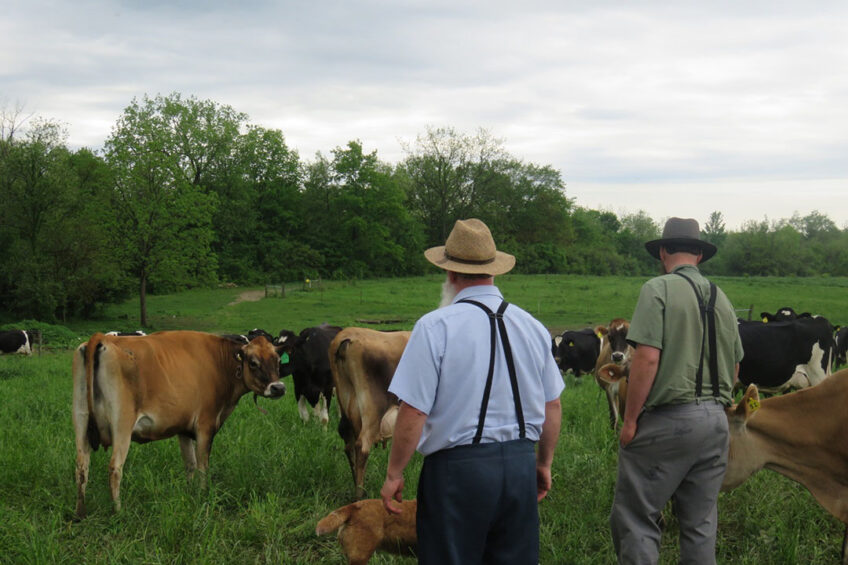Dairy farming the Amish way

Making money from dairy cattle works the same way, no matter where you are in the world. Keep your cows healthy and treat them before they get sick, achieve an above-average milk price and control your costs and financing. If you are better than average in all these aspects, you will most certainly remain a farmer.
Middlebury-based Pete Lehman and his son Jay prove that this is the right course of action. Because of their religious beliefs, these Amish farmers in Indiana must overcome quite a few obstacles compared to ‘mainstream’ dairy farmers. The size of their farm for example is limited because all the work in their fields is done with horses. Technological innovations are mostly implemented after 40 years. “Family comes first for us Amish,” says Mr Lehman. “Being successful is not just a financial aspect. You are only successful when you are capable of passing on a profitable farm to the next generation.”

Six times as many cows in 30 years
Mr Lehman and his wife Lena started their farm in 1988 with 16 cows, 60 sows and 150 finishers. They milked their cows by hand until the Amish allowed milking machines in 1992. That is when they started expanding with dairy cattle. The farm quickly grew to 60 cows within the existing buildings. They abandoned pig farming in 1998 because there was no longer a market for smaller operators. They built a new barn with 108 free stalls and a feeding space in 2001. Mr Lehman did not completely fill this barn, he stopped at 70 cows. “The milk price was too good back then. I still regret it. Looking back, it was a completely wrong decision.”
In 2017, Mr Lehman’s son Jay entered the farm. He is not the youngest son, contrary to Amish tradition. “The youngest and second youngest were not ready for this responsibility,” he says. “Third of the five sons, Jay was keen, already married and his wife believes in the farm and is supportive. He is also a member of the Amish church.”

Using horses means more family time
All the work in the field must be done with horses. Even then, maintaining capacity is possible, because they pull a little wagon with a 118 hp power source that powers the towed machinery. Mr Lehman has a 3-metre-wide mower/conditioner (MoCo), a robust round baler and a silage bagging machine (tube filler) that they have in joint possession with a neighbour to cut costs.
The horses are crucial. They can work for about four hours before they have to be fed and rested. In practise, that means the Lehman’s work in the field from approximately 07:00am to 11:30am, then take a 90-minute break and resume work from 13:30pm until about 17:00pm. “This means that there is time for the family as well. Horses bring peace in your life, you cannot use them for 16 hours straight,” Mr Lehman says
This rich family life is what it is all about for Mr Lehman and the Amish community. Many families have seven or more children, they take care of many chores, such as feeding the calves and milking. “This is how they learn responsibility and what it means to work. Anyone that does not know at 18 what working is, will never learn,” Mr Lehman says. It also helps keep labour costs at these labour-intensive companies low.

“We have given all our children a proper education and a set of ethical norms. We also taught them a good attitude towards work, responsibility and a love for all living things,” says Mr Lehman. “This will get them far in life.” Their parents’ financial support helps as well. They do not give them cash, but they provide a guarantee of equity. “In this way we can help them achieve something they could never have done on their own.”
Mr Lehman has ten draught horses and uses eight of them at a time at most. An extra set of horses would significantly increase capacity and the maximum size of the farm. It is still not an option because of the costs and the limited number of days the extra capacity is necessary. After all, feeding horses amounts to around € 1,200 year. Apart from that, they barely create costs. The bottom line is that horses are cost effective. After all, the annual cost of a decent tractor is more than € 12,000.

Organic the American way
The Lehman’s work organically. The American demands deviate from the European ones in some way. Pasturing is mandatory, not as 120 days, 6 hours per day but through the demand that at least 30% of the dry matter needs to come from grass, for 120 days a year. The use of chemical pesticides is forbidden and nitrogen from fertiliser should be avoided at all costs, that is why the Lehman’s use a significant amount of dry poultry manure every year. The supply of fertiliser, phosphate and potash is allowed. Using antibiotics is also allowed, but the products of a treated animal cannot have the ‘organic’ label. That means disposing of the animal after recovery. “We had to do that once in the past five years.” There are a few animals with a coloured strap around their feet. A red band means a part of the udder is not producing milk suitable for consumption (due to infection), a green band means fresh cow’s milk (colostrum) not suitable for consumption.

Mr Lehman sells his products through Cropp, a marketing cooperative in Wisconsin. It owns the strongest organic brand in the United States: Organic Valley. “This cooperation was founded by a bunch of Wisconsin hippies, originally for selling vegetables. They want to help and support farmers, especially the smaller ones. They really care about us and work hard to keep prices high. They fundamentally see farming as a way of life, just as we do. Therefore, we and many other Amish in this region sell through this cooperation.” The milk price is more than good, he continues. He makes about € 52 per 100 kg, also because of the high fat and protein levels. Mainstream dairy farmers do not get more than € 33.
A characteristic example is the way the cooperation handles the supply of milk. There is a quota based on the supply in the previous year, with a correction for the expected demand in the current year. Mr Lehman went from 70 to 96 dairy cows after 2016 because he bought Jerseys. “We chose these because of their fatty milk. But on average they don’t perform any better than our New-Zealand Frisians.”

This expansion above quota would mean a levy of € 0.20 cents (converted) per kilogramme of milk. This was brought down to € 0.4 cents. “This does not cause any problems within the cooperation. There are few growers and farmers that understand that growth is necessary for acquisition.” Because the milk price was bad after the expansion, the aspect of cash-flow became a little intense at the farm. “We had to apply for additional funding, which amounts to € 275.000 at an annual milk supply of 593,000 kilogrammes.”
This milk production will probably increase up to 750,000 kilogrammes in the coming years. Jay says that he wants to have 108 continuously lactating cows soon. In preparation for this, the young stock was subcontracted to a retired farmer this year. That amounts to around € 8.000 a year for roughage, care and housing. “The 108 dairy cows are expected in 2020,” says Jay, eyeing his father. “After that, I want to invest in an irrigation canon. That could lead to a 30% increase in the yield of our pastures.”
Growth, knowledge and funding
They never really discussed this growth rate and the irrigation canon comes as a complete surprise. Mr Lehman, however, immediately agrees, “seems like a good plan to me. You really thought it through.” A moment later Mr Lehman says: “I have observed quite a few farms where the father has a tendency to hold the son back. I don’t want to make that mistake, even though I notice I am more conservative than 20 years ago. But Jay has to be able to make mistakes in order to learn.”
Jay does not get carte blanche however. Mr Lehman keeps an eye on everything. He did not start a study group with five neighbouring farmers in 2008 for nothing. “By comparing our technical and financial numbers three times a year, we have all learned and earned a great deal,” he says. That one group grew to five study groups with 40 members in a radius of 40 kilometres around the farm.

Pete tends to worry about his colleagues’ lack of knowledge. The Amish often enter the farm at a young age, after eight years of school, supplemented with winter courses and study days. “Many companies encounter financial problems three years after an acquisition and a growth spurt. This often has to do with udders and fertility. The production decreases and there is no money to replace animals. That is when the downward spiral continues,” he says.
The Amish community started a fund to tackle this problem: The Community Aiding Local Farmers (Calf). Newly started entrepreneurs that experience serious problems after an acquisition can borrow money from Calf for three years without interest. After that, for two years at 2%, providing the young farmer allows two mentors, successful and experienced farmers, to guide him in this period.
“They come to us for money, but they learn the most from the intensive supervision.” Why does the community only do this when a farm threatens to go bankrupt and not at the moment of the acquisition? “Actually, we did not look at it that way. This is something I will propose.
Profile Names: Pete (57) and Jay (24) Lehman |
| The Lehman farm A neighbouring (retired) farmer with 24 hectares of pasture handles the breeding of young stock after about 10 days. He receives about € 8.000 a year for housing, caring and roughage. 16 of the 70 hectares are used for pasturing, 12 for alfalfa for silage, 15 hectares of corn and 4 hectares for growing sorghum. After the harvest, fodder beets are sowed that the cows pasture in the fall. In addition to this, there are 20 hectares of production forest and 3 hectares in use for the buildings. The cows’ ration consists of pasturing or silage supplemented with 6 kilogrammes of dry matter silage maize and a 2,5-kilogramme mixture of bean meal, oats, barley and ear corn. They cows are rated through the TripleA-system. Most cows and yearlings are inseminated through artificial insemination. |
Amish This why milking with machines are allowed in Lehman’s circle. This also means electricity, that can only be generated by the farmers themselves, with their own power unit. This power can only be used for milking, milk cooling and for cooling cattle. In the house itself, butane gas is used for cooking, heating and lighting. Batteries are allowed. “This is why we use a little led light on our hats,” explains Mr Lehman. “If needed for work, we have a light with us.” Horses pull the agricultural machinery, but a power source is allowed for driving machines and tools. A self-propelled vehicle is allowed on the building block. Lehman’s skid steer is used for long hours unloading silage and grain and cleaning slatted floors. A 100 hp John Deere drives the mixer-feeder. Passenger transport must be done by bike or with a horse-drawn vehicle. Because of traffic safety, these buggies are equipped with a battery-fed lighting bar and flashers. The informal line for long-distance transport is about 20 kilometres or an hour and a half with the buggy. Amish can use a taxi that is owned and operated by a non-Amish. |
Join 13,000+ subscribers
Subscribe to our newsletter to stay updated about all the need-to-know content in the dairy sector, two times a week.










